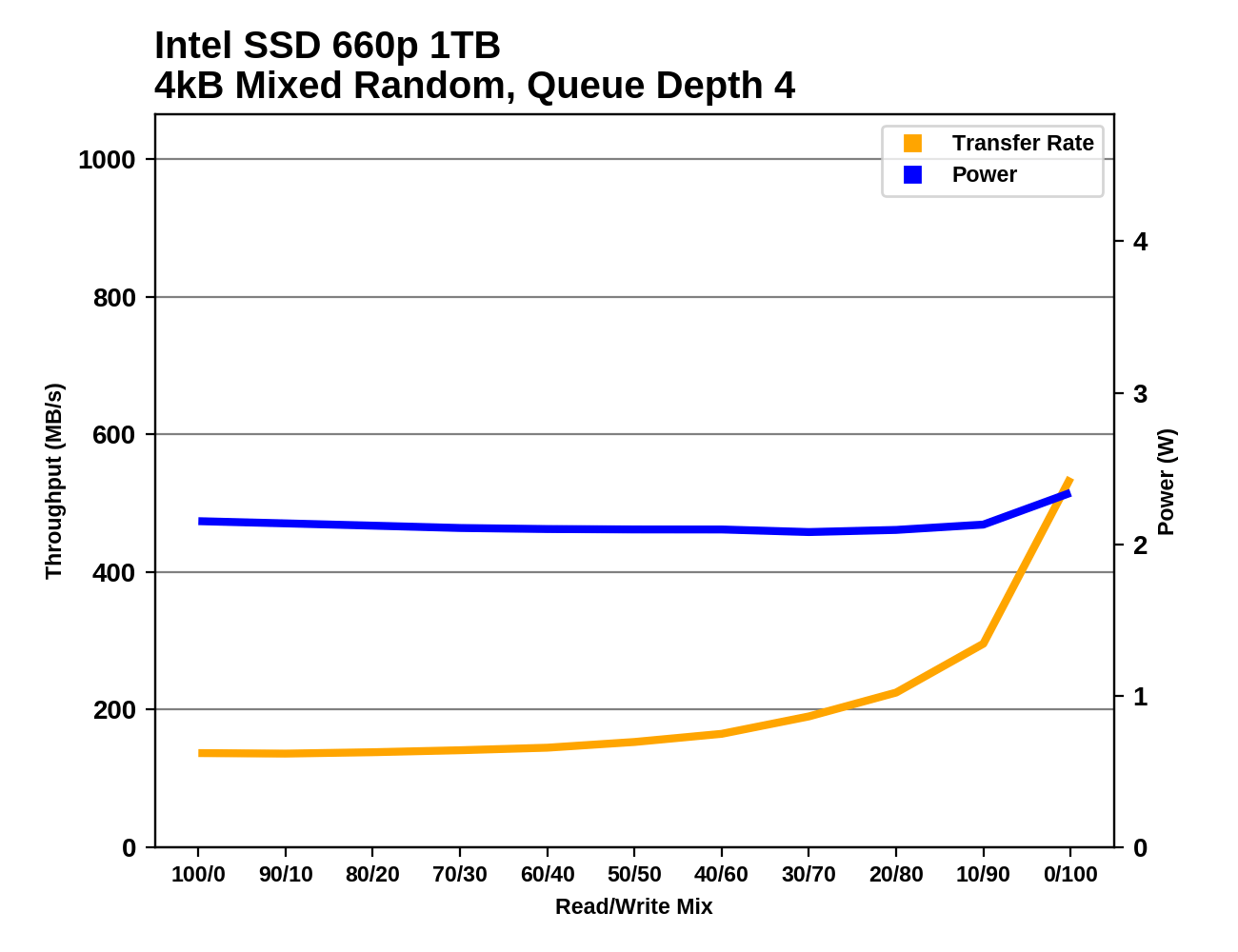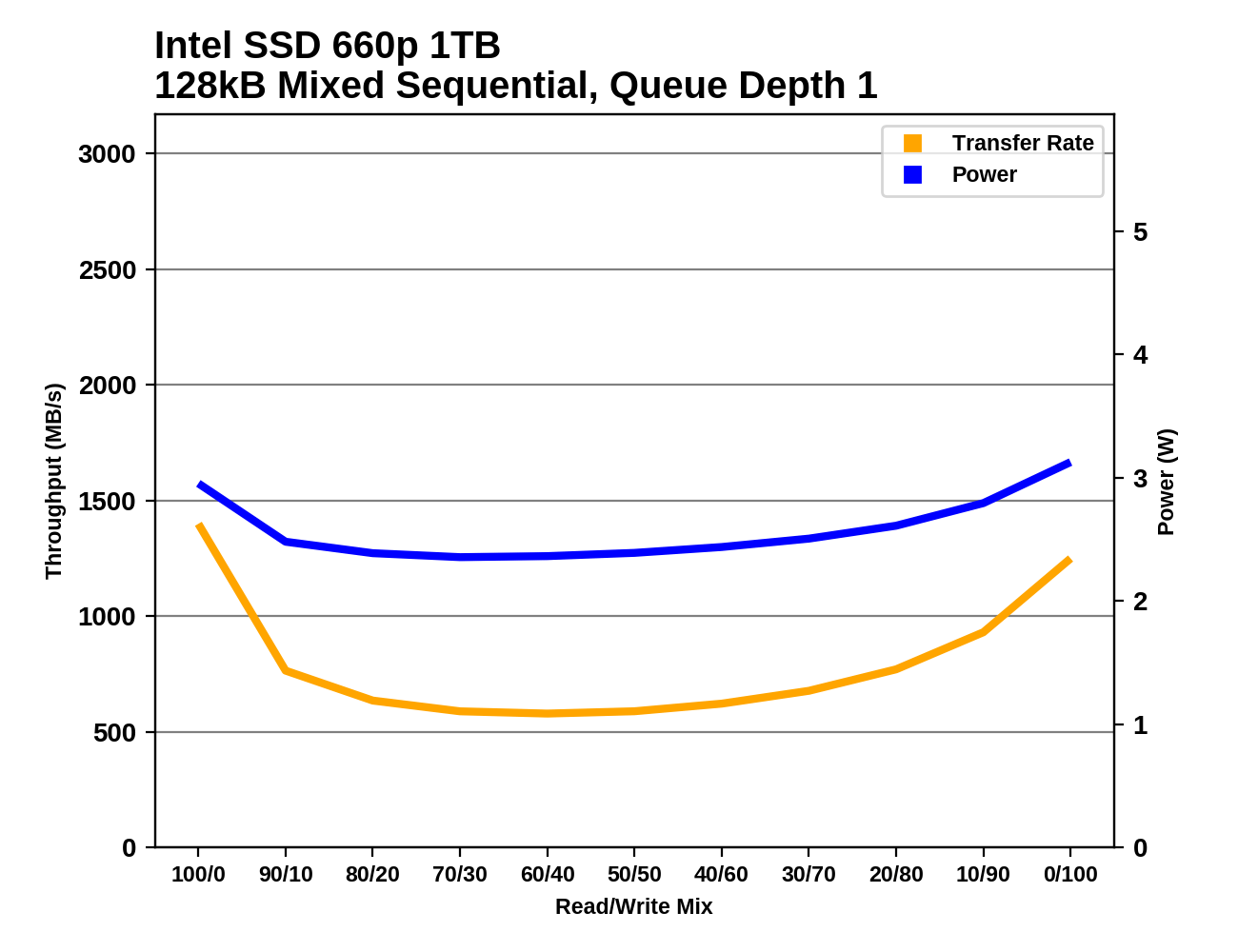The Intel SSD 660p SSD Review: QLC NAND Arrives For Consumer SSDs
by Billy Tallis on August 7, 2018 11:00 AM ESTMixed Random Performance
Our test of mixed random reads and writes covers mixes varying from pure reads to pure writes at 10% increments. Each mix is tested for up to 1 minute or 32GB of data transferred. The test is conducted with a queue depth of 4, and is limited to a 64GB span of the drive. In between each mix, the drive is given idle time of up to one minute so that the overall duty cycle is 50%.

The mixed random I/O performance of the Intel SSD 660p is clearly above the other low-end NVMe drives we've tested, or the Crucial MX500 SATA drive. It scores closer to a mid-range NVMe SSD. After filling the drive, performance is cut in half, leaving it performing near low-end NVMe drives like the Phison E8-based Kingston A1000 and below the MX500.
 |
|||||||||
| Power Efficiency in MB/s/W | Average Power in W | ||||||||
The power efficiency of the 660p during the mixed random I/O test is unimpressive but doesn't stand out as being significantly worse that other low-end NVMe drives even when the test is run on a full drive.
 |
|||||||||
The Intel SSD 660p shows very slow performance growth throughout most of the test, but it picks up speed reasonably well toward the end as the workload shifts toward pure writes, and the SLC cache handles things well. When the drive is full, the reduced capacity of the SLC cache prevents speed from increasing much.
Mixed Sequential Performance
Our test of mixed sequential reads and writes differs from the mixed random I/O test by performing 128kB sequential accesses rather than 4kB accesses at random locations, and the sequential test is conducted at queue depth 1. The range of mixes tested is the same, and the timing and limits on data transfers are also the same as above.

The Intel SSD 660p performs better than other entry-level NVMe SSDs or SATA drives when the mixed sequential I/O test is run on a mostly empty drive with a large SLC cache. After the drive is filled, performance drops down to slightly ahead of the 600p and Crucial MX500.
 |
|||||||||
| Power Efficiency in MB/s/W | Average Power in W | ||||||||
The power efficiency of the Intel SSD 660p during the mixed sequential I/O test is decent when operating entirely out of the SLC cache, and on par with most other low-end NVMe drives when the 660p is full.
 |
|||||||||
When the test is run on a mostly-empty 660p the performance shows a very typical bathtub curve and no sign of the SLC cache running out. When the drive is full, performance decreases steadily as the proportion of writes increases.










86 Comments
View All Comments
DanNeely - Tuesday, August 7, 2018 - link
Over 18 months between 2013 and 2015 Tech Report tortured a set of early generation SSDs to death via continuous writing until they failed. I'm not aware of anyone else doing the same more recently. Power off retention testing is probably beyond anyone without major OEM sponsorship because each time you power a drive on to see if it's still good you've given its firmware a chance to start running a refresh cycle if needed. As a result to look beyond really short time spans, you'd need an entire stack of each model of drive tested.https://techreport.com/review/27909/the-ssd-endura...
Oxford Guy - Tuesday, August 7, 2018 - link
Torture tests don't test voltage fading from disuse, though.StrangerGuy - Tuesday, August 7, 2018 - link
And audiophiles always claim no tests are ever enough to disprove their supernatural hearing claims, so...Oxford Guy - Tuesday, August 7, 2018 - link
SSD defects have been found in a variety of models, such as the 840 and the OCZ Vertex 2.mapesdhs - Wednesday, August 8, 2018 - link
Please explain the Vertex2, because I have a lot of them and so far none have failed. Or do you mean the original Vertex2 rather than the Vertex2E which very quickly replaced it? Most of mine are V2Es, it was actually quite rare to come across a normal V2, they were replaced in the channel very quickly. The V2E is an excellent SSD, especially for any OS that doesn't support TRIM, such as WinXP or IRIX. Also, most of the talk about the 840 line was of the 840 EVO, not the standard 840; it's hard to find equivalent coverage of the 840, most sites focused on the EVO instead.Valantar - Wednesday, August 8, 2018 - link
If the Vertex2 was the one that caused BSODs and was recalled, then at least I had one. Didn't find out that the drive was the defective part or that it had been recalled until quite a lot later, but at least I got my money back (which then paid for a very nice 840 Pro, so it turned out well in the end XD).Oxford Guy - Friday, August 10, 2018 - link
Not recalled. There was a program where people could ask OCZ for replacements. But, OCZ also "ran out" of stock for that replacement program and never even covered the drive that was most severely affected: the 240 GB 64-bit NAND unit.BurntMyBacon - Wednesday, August 8, 2018 - link
I believe the problems that plagued the 840 EVO were relevant to the 840 based on two facts. Both SSDs used the same flash. Samsung eventually released a (partial) fix for the 840 similar to the 840 EVO. The fix was apparently incompatible with Linux/BSD, though.Spunjji - Wednesday, August 8, 2018 - link
You'd also be providing useless data by doing so. The drives will have been superseded at least twice before you even have anything to show from the (very expensive) testing.JoeyJoJo123 - Tuesday, August 7, 2018 - link
>muh ssd endurance boogeymanLike clockwork.